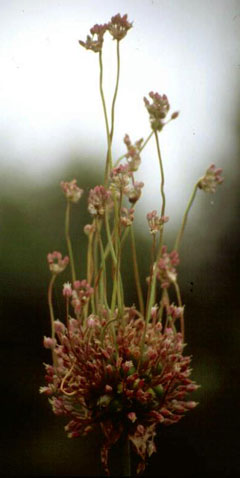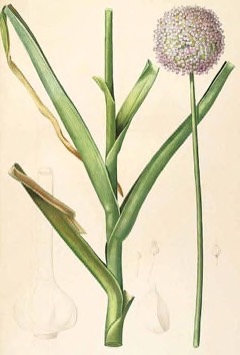 |
|
(c) 2010 Ken Fern, Plants For A Future |
 |
|
Translate this page:
Summary
Physical Characteristics

 Allium_ampeloprasum is a BULB growing to 1.8 m (6ft) by 0.1 m (0ft 4in).
Allium_ampeloprasum is a BULB growing to 1.8 m (6ft) by 0.1 m (0ft 4in).
See above for USDA hardiness. It is hardy to UK zone 6 and is not frost tender. It is in leaf from October to August, in flower from July to August, and the seeds ripen in August. The species is hermaphrodite (has both male and female organs) and is pollinated by Bees, insects.
Suitable for: light (sandy), medium (loamy) and heavy (clay) soils, prefers well-drained soil and can grow in heavy clay soil. Suitable pH: mildly acid, neutral and basic (mildly alkaline) soils and can grow in very alkaline soils.
It cannot grow in the shade. It prefers dry or moist soil. The plant can tolerates strong winds but not maritime exposure.
UK Hardiness Map
US Hardiness Map
Synonyms
Plant Habitats
Edible Uses
Bulb - raw or cooked[2, 27, 61, 105]. The small bulbs can vary considerably in size from 2 - 6cm[200], they have a fairly strong leek to garlic flavour and are nice as a flavouring in cooked foods[K]. The bulbs of selected cultivars are very large with a mild garlic flavour[183]. Leaves - raw or cooked[2]. A pleasant mild to strong garlic flavour, they are available from late autumn to the spring though they can become rather tough and fibrous as they get older[K]. Flowers - raw. A similar flavour to the leaves but they have a somewhat dry texture and are best used as a flavouring in cooked foods[K]. The bulbils have a mild garlic flavour and make a nice flavouring in salads and cooked foods. Although produced abundantly, they are quite fiddly to use because they are small[K]. They can also be pickled[142].
References More on Edible Uses
Medicinal Uses
Plants For A Future can not take any responsibility for any adverse effects from the use of plants. Always seek advice from a professional before using a plant medicinally.
This species has the same medicinal virtues as garlic, but in a much milder and less effective form[238]. These virtues are as follows:- Garlic has a very long folk history of use in a wide range of ailments, particularly ailments such as ringworm, Candida and vaginitis where its fungicidal, antiseptic, tonic and parasiticidal properties have proved of benefit[218]. It is also said to have anticancer activity[218]. Daily use of garlic in the diet has been shown to have a very beneficial effect on the body, especially the blood system and the heart. For example, demographic studies suggest that garlic is responsible for the low incidence of arteriosclerosis in areas of Italy and Spain where consumption of the bulb is heavy[222]. The bulb is said to be anthelmintic, antiasthmatic, anticholesterolemic, antiseptic, antispasmodic, cholagogue, diaphoretic, diuretic, expectorant, febrifuge, stimulant, stomachic, tonic, vasodilator[4, 9, 14, 21, 46, 165]. The crushed bulb may be applied as a poultice to ease the pain of bites, stings etc[4, 9, 14, 21].
References More on Medicinal Uses
The Bookshop: Edible Plant Books
Our Latest books on Perennial Plants For Food Forests and Permaculture Gardens in paperback or digital formats.

Edible Tropical Plants
Food Forest Plants for Hotter Conditions: 250+ Plants For Tropical Food Forests & Permaculture Gardens.
More

Edible Temperate Plants
Plants for Your Food Forest: 500 Plants for Temperate Food Forests & Permaculture Gardens.
More

More Books
PFAF have eight books available in paperback and digital formats. Browse the shop for more information.
Shop Now
Other Uses
The juice of the plant is used as a moth repellent. The whole plant is said to repel insects and moles[20].
Special Uses
References More on Other Uses
Cultivation details
Prefers a sunny position in a light well-drained soil[1]. Prefers a dry position[45]. Succeeds in clay soils[203]. Tolerates a pH in the range 5.2 to 8.3. The bulbs should be planted fairly deeply[1]. The wild leek is a rare native of Britain, found only in the south-west and Wales, though it should be hardy in most parts of the country. It comes into growth in the autumn, dying down in the summer, and makes a very pleasant winter leaf, either raw or cooked. It is a rather variable plant, especially in the amount of flowers and bulbils produced. The species produces mainly flowers with almost no bulbils, whilst the sub-species A. ampeloprasum babbingtonii (Babbington's Leek) produces lots of bulbils and almost no flowers[17]. The cultivated leek (A. ampeloprasum porrum) is believed to have been developed from this plant whilst, in Germany and Italy, other forms have been selected for their edible bulbils[142]. Allium ampeloprasum comprises several vegetables, of which the most important ones are: leek, elephant garlic or great-headed garlic, pearl onion, kurrat, Egyptian leek or salad leek, and Persian leek (Allium ampeloprasum ssp. persicum). The cultivar 'Perizweibel' is often used, the bulbils are solid rather than made up of layers and are popularly used for making pickles[183]. This cultivar does not set seed[183]. Another cultivated form of this plant produces very large, mild-garlic flavoured bulbs that are up to 500g in weight[183].They are known as elephant garlic[183]. The wild leek grows well with most plants, especially roses, carrots, beet and chamomile, but it inhibits the growth of legumes[18, 20, 54]. This plant is a bad companion for alfalfa, each species negatively affecting the other[201]. Members of this genus are rarely if ever troubled by browsing deer[233]. For polyculture design as well as the above-ground architecture (form - tree, shrub etc. and size shown above) information on the habit and root pattern is also useful and given here if available. The plant growth habit is a clumper with limited spread [1-2]. The root pattern is a bulb.
References Carbon Farming Information and Carbon Sequestration Information
Temperature Converter
Type a value in the Celsius field to convert the value to Fahrenheit:
Fahrenheit:
The PFAF Bookshop
Plants For A Future have a number of books available in paperback and digital form. Book titles include Edible Plants, Edible Perennials, Edible Trees,Edible Shrubs, Woodland Gardening, and Temperate Food Forest Plants. Our new book is Food Forest Plants For Hotter Conditions (Tropical and Sub-Tropical).
Shop Now
Plant Propagation
Seed - best sown as soon as it is ripe in a cold frame, though it can also be sown in a cold frame in the spring[200]. Prick out the seedlings into individual pots when they are large enough to handle. Well-grown plants can be planted out into their final positions in late summer or the autumn, otherwise grow them on for a further year in pots and plant them out the following summer. Division in late summer or early autumn. Dig up the bulbs when the plants are dormant and divide the small bulblets at the base of the larger bulb. Replant immediately, either in the open ground or in pots in a cold frame. Bulbils - plant out as soon as they are ripe in late summer. The bulbils can be planted direct into their permanent positions, though you get better results if you pot them up and plant them out the following spring.
Other Names
If available other names are mentioned here
Native Range
TEMPERATE ASIA: Armenia, Azerbaijan, Cyprus, Egypt, Iraq, Israel, Jordan, Lebanon, Sinai, Syria, Turkey,Saudi Arabia. EUROPE: United Kingdom (U.K.), Ireland, Ukraine (incl. Krym), Former Yugoslavia, Greece (incl. Crete), Italy (incl. Sardinia, Sicily), Spain (incl. Baleares), France (incl. Corsica), Portugal, AFRICA: Spain, Canarias, Algeria (north), Egypt, Libya (north), Morocco, Tunisia.
Weed Potential
Right plant wrong place. We are currently updating this section.
Please note that a plant may be invasive in one area but may not in your area so it’s worth checking.
Conservation Status
IUCN Red List of Threatened Plants Status :

Growth: S = slow M = medium F = fast. Soil: L = light (sandy) M = medium H = heavy (clay). pH: A = acid N = neutral B = basic (alkaline). Shade: F = full shade S = semi-shade N = no shade. Moisture: D = dry M = Moist We = wet Wa = water.
Expert comment
Author
L.
Botanical References
17200
Links / References
For a list of references used on this page please go here
Readers comment